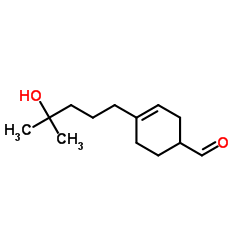新铃兰醛

新铃兰醛结构式

|
常用名 | 新铃兰醛 | 英文名 | 4-(4-Hydroxy-4-methylpentyl)cyclohex-3-enecarbaldehyde |
|---|---|---|---|---|
| CAS号 | 31906-04-4 | 分子量 | 210.313 | |
| 密度 | 1.0±0.1 g/cm3 | 沸点 | 318.7±42.0 °C at 760 mmHg | |
| 分子式 | C13H22O2 | 熔点 | N/A | |
| MSDS | 中文版 美版 | 闪点 | 135.1±20.5 °C |
|
Enhanced sensitization and elicitation responses caused by mixtures of common fragrance allergens.
Contact Dermatitis 65(6) , 336-42, (2011) Perfumes are complex mixtures composed of many fragrance ingredients, many of which are known to be only weak allergens when tested individually. It is therefore surprising that fragrance contact allergy is one of the most common forms of contact allergy.To i... |
|
|
Can exposure limitations for well-known contact allergens be simplified? An analysis of dose-response patch test data.
Contact Dermatitis 64(6) , 337-42, (2011) Allergic contact dermatitis is triggered by chemicals in the environment. Primary prevention is aimed at minimizing the risk of induction, whereas secondary and tertiary prevention are aimed at reducing elicitation.To identify the elicitation doses that will ... |
|
|
Experimental elicitation with hydroxyisohexyl-3-cyclohexene carboxaldehyde-containing deodorants.
Contact Dermatitis 56(3) , 146-50, (2007) Hydroxyisohexyl-3-cyclohexene carboxaldehyde (HICC) known as Lyral is a frequent allergen. It is used in more than 50% of marketed deodorants. The aim of the present study was to determine elicitation thresholds for HICC under simulated conditions of deodoran... |
|
|
[Current contact allergens].
Hautarzt 62(10) , 751-6, (2011) Ever-changing exposure to contact allergens, partly due to statutory directives (e.g. nickel, chromate, methyldibromo glutaronitrile) or recommendations from industrial associations (e.g. hydroxyisohexyl 3-cyclohexene carboxaldehyde), requires on-going epidem... |
|
|
Two fragrance chemicals may act as toxicants via TRPA1 stimulation rather than via direct mitochondrial action.
Toxicol. In Vitro 27(6) , 2022, (2013)
|
|
|
Fragrance contact allergy: a 4-year retrospective study.
Contact Dermatitis 63(2) , 77-84, (2010) Fragrance chemicals are the second most frequent cause of contact allergy. The mandatory labelling of 26 fragrance chemicals when present in cosmetics has facilitated management of patients allergic to fragrances.The study was aimed to define the characterist... |
|
|
Fragrance chemicals lyral and lilial decrease viability of HaCat cells' by increasing free radical production and lowering intracellular ATP level: protection by antioxidants.
Toxicol. In Vitro 27(1) , 339-48, (2013) We investigate in this study the biochemical effects on cells in culture of two commonly used fragrance chemicals: lyral and lilial. Whereas both chemicals exerted a significant effect on primary keratinocyte(s), HaCat cells, no effect was obtained with any o... |
|
|
An odor-specific threshold deficit implicates abnormal cAMP signaling in youths at clinical risk for psychosis.
Schizophr. Res. 138(2-3) , 280-4, (2012) While olfactory deficits have been reported in schizophrenia and youths at-risk for psychosis, few studies have linked these deficits to current pathophysiological models of the illness. There is evidence that disrupted cyclic adenosine 3',5'-monophosphate (c... |
|
|
Hydroxyisohexyl 3-cyclohexene carboxaldehyde (Lyral®) as allergen: experience from a contact dermatitis unit.
Cutan. Ocul. Toxicol. 30(3) , 249-50, (2011) Hydroxyisohexyl 3-cyclohexene carboxaldehyde (HICC)-Lyral® is a widely used synthetic fragrance found in personal care and household products. It is an aldehyde, lipophilic enough to penetrate the skin and is a frequent cause of contact sensitization.Describe... |
|
|
Prevalence of allergic contact dermatitis caused by hydroxyisohexyl 3-cyclohexene carboxaldehyde has not changed in Denmark.
Contact Dermatitis 67(1) , 49-51, (2012)
|